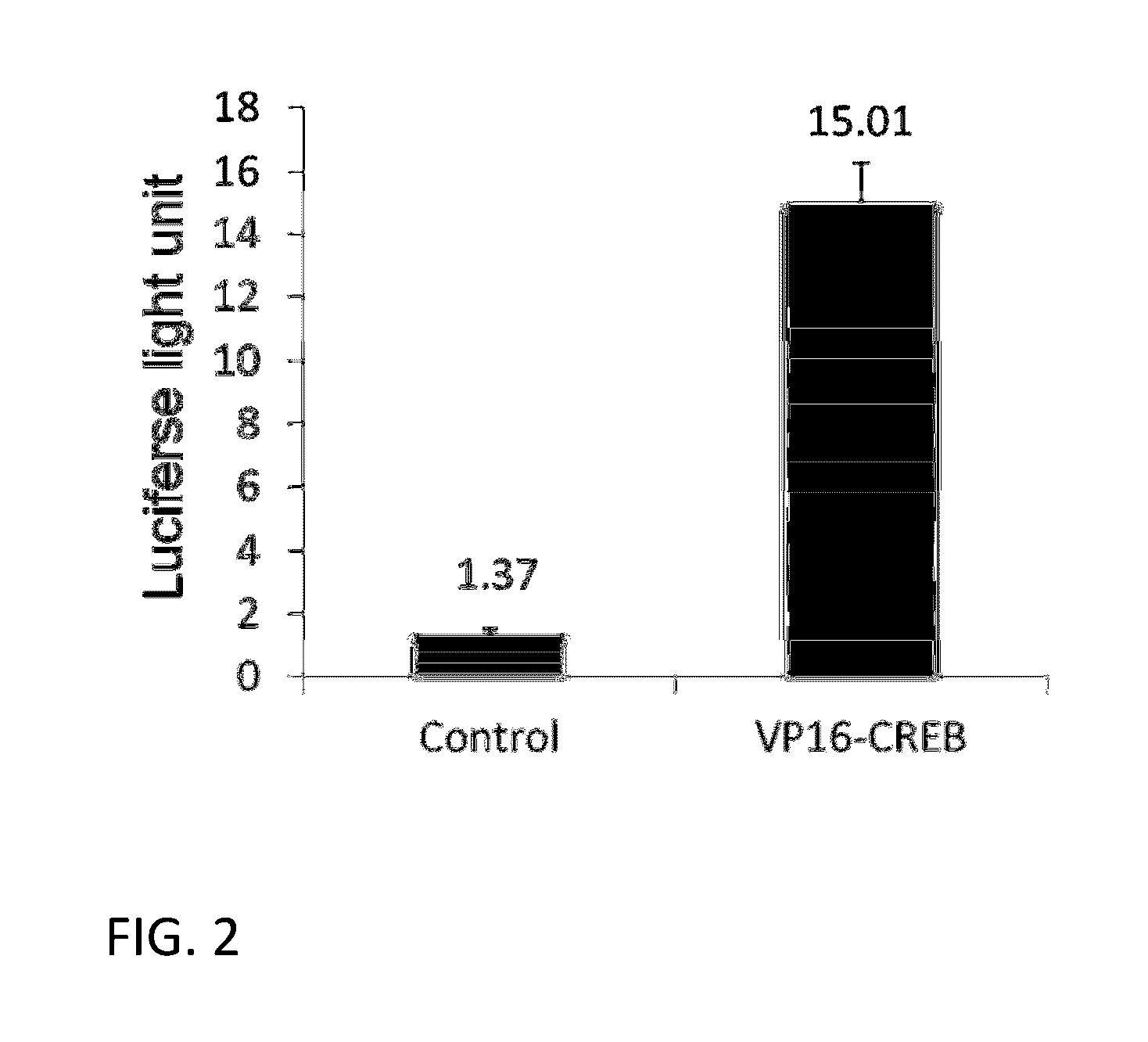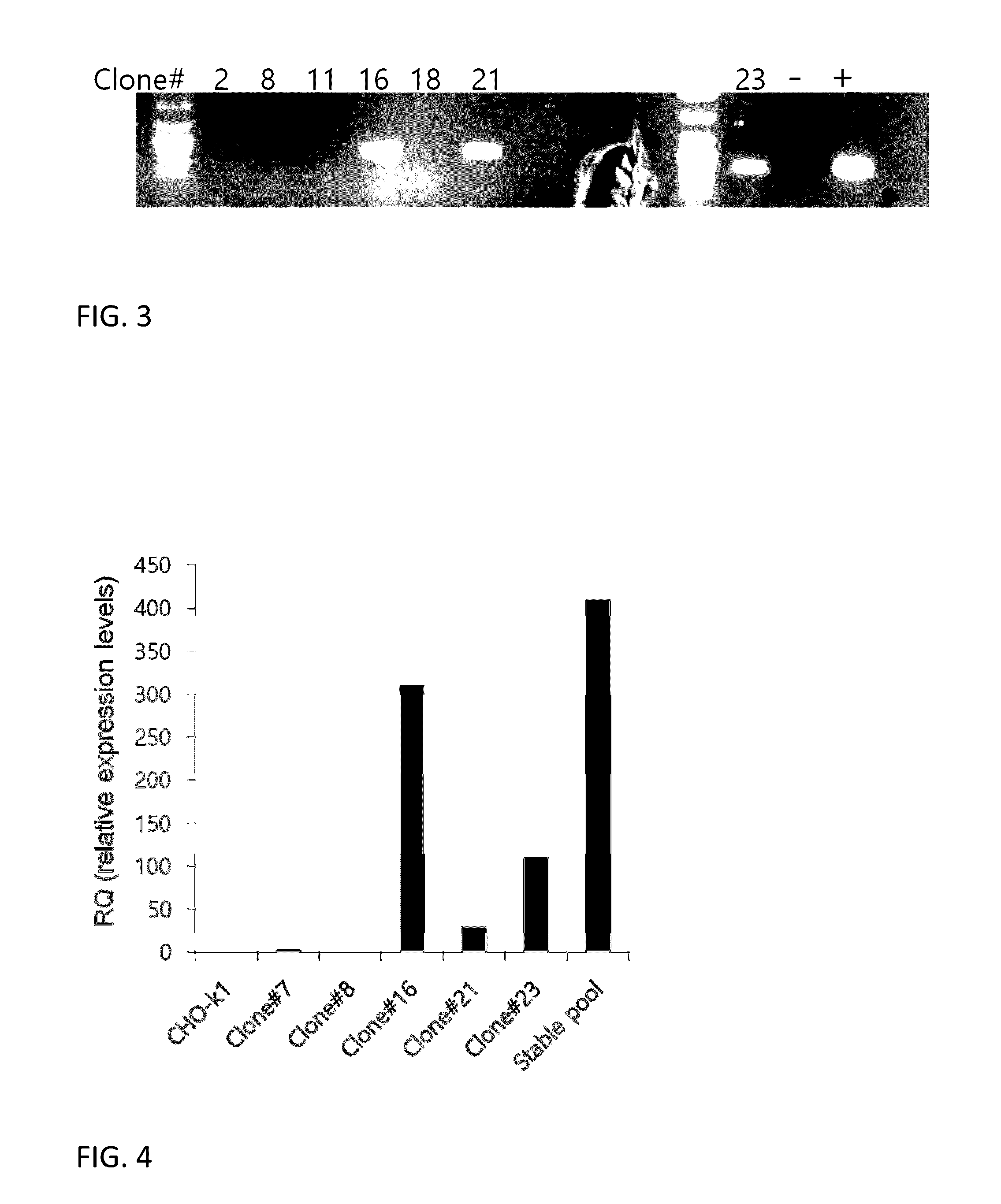VP16-CREB fusion gene
a fusion gene and gene technology, applied in the field of vp16creb fusion gene, can solve the problems of large-scale production of protein therapeutics in animal cells, such as cho cells, that is difficult to achieve the effect of large-scale use of dg44 cells, low efficiency, and high cos
- Summary
- Abstract
- Description
- Claims
- Application Information
AI Technical Summary
Benefits of technology
Problems solved by technology
Method used
Image
Examples
example 1
Materials
[0088]CHO Cells:
[0089]CHO cells were purchased from ATCC (Manassas, Va.)
[0090]Item Number: CCL-61
[0091]Description: CHO-k1; Ovary, Chinese Hamster (Cricetulus griseus)
[0092]Geneticin: Life Technologies (Item #10131)
[0093]CDM4CHO medium: Thermo Scientific (Hyclone, SH30557)
[0094]L-Glutamine: Lonza (17-605E)
[0095]DPBS: Lonza (17-512F / 12)
[0096]F-12K medium: ATCC (30-2004)
[0097]Fetal Bovine Serum: Invitrogen (10438026)
[0098]Trypsin 0.25% EDTA: Invitrogen (25200072)
example 2
[0099]A plasmid vector containing the VP16-CREB fusion gene under the control of CMV promoter and the neomycin-resistance gene as a selectable marker was prepared, using Promega's pFN10A (ACT) Flexi Vector. The resulting plasmid was named pVP16-CREB.
[0100]The effect of overexpressing VP16-CREB fusion gene in CHO cells on the expression of stably transfected gene under CMV promoter control was tested first under conditions similar to therapeutics gene expression cases. For this, we have generated a stable CHO-k1 cell line expressing both firefly luciferase gene and human recombinant green fluorescence gene (hrGFP) under the control of CMV promoter separately. This was done by transfecting CHO-k1 cells with a plasmid vector containing the two genes and neomycin-resistance gene as a selectable marker. This vector is named as pCN-LG. A pool of stably expressing cells was prepared by adding G-418 in the culture medium and growing cells for 2-3 weeks. Stable pool of CHO-k1 cells (CHO-k1-L...
example 3
[0107]Based on these results, an experiment was performed to generate CHO-k1 cell line stably expressing VP16-CREB. CHO-k1 cells preadapted to suspension culture in chemically defined medium were used for the experiment. Two million cells were used for transfection by electroporation using 2.5 μg of plasmid DNA. Transfection was performed five times for total 10 million cells and cells were pooled together in a 50 ml bioreactor with 10 ml of culture medium (CDM4CHO). Two days after transfection, G-418 was added to the medium at 400 μg / ml concentration for the selection of stably transfected cells. Cell medium (with G-418) was replaced every 3-5 days, and cell counting and viability check were performed every 24 hours. Approximately 17 days after the transfection, stably transfected cells surviving G-418 selection were plated in six 96-well plates by limiting dilution at 1 cell per well density in 200 μl of 1:1 mixture CDM4CHO and a conditioned medium prepared from CHO-k1 cells, plus...
PUM
| Property | Measurement | Unit |
|---|---|---|
| concentration | aaaaa | aaaaa |
| density | aaaaa | aaaaa |
| volume | aaaaa | aaaaa |
Abstract
Description
Claims
Application Information
 Login to View More
Login to View More - Generate Ideas
- Intellectual Property
- Life Sciences
- Materials
- Tech Scout
- Unparalleled Data Quality
- Higher Quality Content
- 60% Fewer Hallucinations
Browse by: Latest US Patents, China's latest patents, Technical Efficacy Thesaurus, Application Domain, Technology Topic, Popular Technical Reports.
© 2025 PatSnap. All rights reserved.Legal|Privacy policy|Modern Slavery Act Transparency Statement|Sitemap|About US| Contact US: help@patsnap.com



